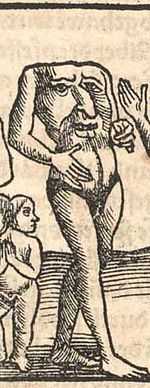Headless men
- For the non-legendary tribe see Blemmyes.
.jpg)

Various species of mythical headless men were rumored, in antiquity and later, to inhabit remote parts of the world. They are variously known as akephaloi (Greek ἀκέφαλοι,[1] headless ones) or Blemmyes (Latin Blemmyae) and described as having a mouth in their chest and eyes in their shoulders.[1]
According to Herodotus, in his Histories, the inhabitants of ancient Libya claimed the existence of these creatures in the eastern part of their lands, as well as cynochephali, "and the wild men and women, besides many other creatures not fabulous".[1] In a similar vein, Pliny the Elder in the Natural History mentions the (historical) Blemmyae tribe of North Africa as "said to have no heads, their mouths and eyes being seated in their breasts".[2] He situates the Blemmyae somewhere in Aethiopia.[2]
Some authors derive the story of the Blemmyes from this, that their heads were hid between their shoulders, by hoisting those up to an extravagant height.[citation needed] Samuel Bochart derives the word Blemmyes from two Hebrew terms, one a negation, the other meaning "brain", implying that the Blemmyes were people without brains.[3]
In literature
To the west of Caroli are divers nations of Cannibals, and of those Ewaipanoma without heads. ---Sir Walter Raleigh, The Discovery of Guiana.
And of the Cannibals that each other eat, The Anthropophagi, and men whose heads Do grow beneath their shoulders. ---Shakespeare, Othello (circa 1603).
In Umberto Eco's Baudolino, the protagonist meets Blemmyes along with Sciapods and a number of monsters from the medieval bestiary in his quest to find Prester John.
In his 2006 book La Torre della Solitudine, Valerio Massimo Manfredi features the Blemmyes as fierce, sand-dwelling creatures located in the southeastern Sahara, and suggests that they are the manifestation of the evil face of mankind. Othello makes reference to them as "men whose heads | Do grow beneath their shoulders" [I.iii.143-144].
Science fiction author Bruce Sterling wrote a short story entitled "The Blemmye's Stratagem", included in his collection "Visionary in Residence". The story describes a Blemmye during the Crusades, who turns out to be an extraterrestrial.
Gene Wolfe writes of a man with his face on his chest, located in his short story collection Endangered Species.
Blemmyes appear in the 2000 novel The Amazing Voyage of Azzam by K Godel as cannibalistic tribesmen who guard a lost treasure of King Solomon. They use clubs, spears, and blow darts as weapons.
It is said that the Blemmyae have no heads and that their mouth and eyes are put in their chests. ---Pliny the Elder, Naturalis Historiae (75 CE)
…another island, midway, live people of stature and ugly nature, which have no head and their eyes on the back and mouth, crooked as a horseshoe, in the midst of the breasts. On another island, there are many people without heads, and which has the eyes and head in the back. ---Wonders of the World (1356)
Gaora is a river, on the banks of which are a people whose head grow beneath their shoulders. Their eyes are in their shoulders, and their mouths in the middle of their breasts. ---Hakluyt's Voyage (1598)
Garry Kilworth's story "Out Back" features a Blemmyae.
See also
- Anthropophage
- Blemmyes
- Acephali
- Y'golonac
- Kabandha
- Gossamer (Looney Tunes)
- Kool-Aid Man
- Hitmonlee
- Xing Tian
References
- Blemmyes, in Brewer's Dictionary of Phrase and Fable (1898)
- ↑ 1.0 1.1 1.2 Herodotus. The Histories. Trans. A. D. Godley. 4.191.
- ↑ 2.0 2.1 Pliny the Elder. The Natural History. Trans. John Bostock and H. T. Riley. 5.8.
- ↑